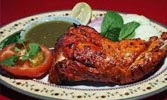Some people would say it's the mix of races where different people of different races live peacefully side by side in harmony.
Well for us, we would say it's the
food!
Malaysia are synonym for the word multi-
Multicultural, multi-ethnic and multilingual society.
These varieties that makes Malaysia described as
'As Asia in Miniature'
Every culture has their own traditional food and in Malaysia every culture embrace each other's traditional food with open mouth.
 |
| Varieties of Malays cuisine |
Different Malay regions are all known for their unique or signature dishes.
For example, in Terengganu, the signature dishes are Nasi Dagang, Keropok Lekor and Laksa Terengganu. In Melaka the people have a taste for hot and spicy dishes thus they are famous for the Asam Pedas.
The Malay cuisine are based on the use of spicy ingredients, spices and herbs.
This is probably because Malaysia a long time ago has been a crossroad for the ancient spice route.
Other than that, Malay cuisine also use a lot of coconut milk to give creamy and rich texture to the dishes.
Some of Malay dishes are influence from the surrounding area.
For example, Thailand , Malaysia's neighbouring country influenced the tomyam.
 |
| Some of Chinese Cuisine |
The Chinese are the second largest population in Malaysia after the Malays.
Their cuisines varies according to the different ethnic groups and in Malaysia the cooking style are derived from Cantonese, Hokkien, Hakka and Teochew.
Chinese cuisines also have been developed in Malaysia into local specialty.
For example, the famous Bak Kut Teh are actually originated from Klang and not from China.
Chinese cuisines that are highly recommended for the locals and tourist to try out are Wanton Mee, Char Kway Teow, Hokkien Prawn Mee and Hainanese Chicken Rice.
These dishes has won the hearts and mouth of Malaysian for a long time.
 |
| The modernized Banana Leaf Rice that can be found in almost all Indian restaurant |
Malaysian Indian cuisines consists of adaptations from the authentic dishes from India and some were inspired by the diverse food culture in Malaysia.
Indian cuisine can also be divided to North Indian and South Indian food but predominantly the South Indian food has more character and taste.
The cuisines usually use curry leaves, whole and powdered spices and ghee.
It could be said that Malaysia Indian famous dish are the 'Banana Leaf Rice' which was served on a banana leaf with varieties of vegetable,curries, pickles and papadom.
The Indian Muslim in Malaysia or typically called as Mamak has developed a distinctly Malaysia style.
The Mamak restaurant offers wide varities of food and the restaurant are open for 24 hours everyday.
Some of Mamak's popular dishes are Nasi Kandar and Mee Goreng Mamak.
So what are you waiting for?
Get your face off from the computer and go and try out all this cultural dishes!
We bet you would be asking for more after a mouthful of these dishes.
Well that's all for now.
See you guys again on the next post where we are going to talk about other ethnic groups in Malaysia and of course about their food.

































